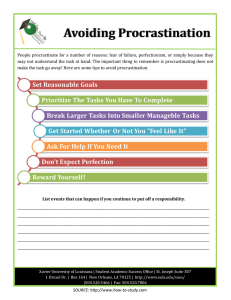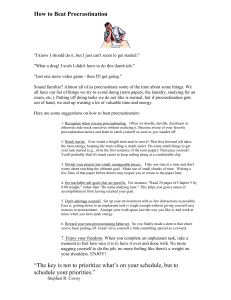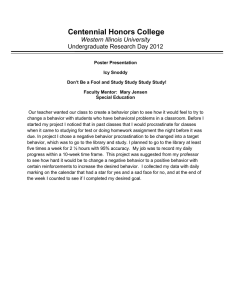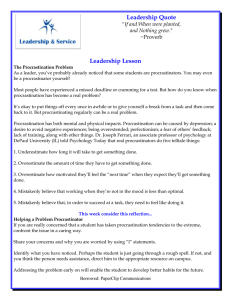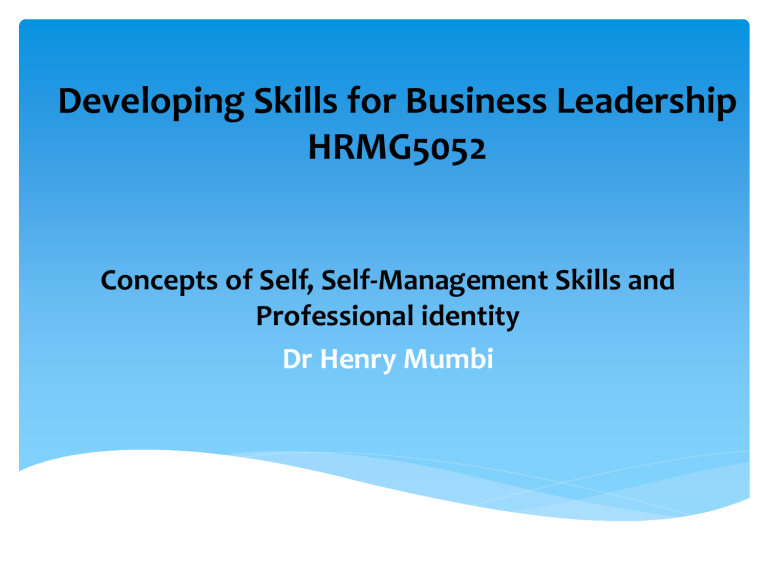
Developing Skills for Business Leadership HRMG5052 Concepts of Self, Self-Management Skills and Professional identity Dr Henry Mumbi Learning Objectives By the end of this session you will be able to: Measure and audit your time Identify any time-wasting activities Recognise instances when you tend to procrastinate Apply strategies to improve your personal time management Appraise the importance of stress management Apply stress management techniques Time management Allows tasks to be accomplished effectively (i.e. doing the right things) Assists task efficiency – optimal use of time Gives you some control of situation Helps to avoid burnout Gives you the awareness of how you are spending your time Activity What strategies can you use to improve on your personal time management? What do managers do? Managers’ lives are characterized by discontinuity. They will take on many roles over a typical day. Mintzberg categorizes these under 3 main headings: 1. Interpersonal 2. Informational 3. Decisional Mintzberg (1990, 1997) Interpersonal roles Figurehead – e.g. as the head of your department, representing your company at ceremonies Leader – giving direction to others in your organisation (includes delegating and developing others) Liaison – acting as a communication link with others outside of the vertical chain of command Informational roles Monitor – keeping an eye open for relevant information; an active scanning approach Disseminator – giving relevant information to staff, for instance in staff briefings and emails Spokesperson – speaking on behalf of the organisation to outsiders Decisional roles Entrepreneur – making things happen, using initiative to get things done Disturbance handler – resolving issues which have not gone to plan, handling arguments Resource allocator – deciding how to apportion limited resources (staff time, budgets, equipment, materials) Negotiator – formal and informal bargaining (for instance with own staff, with customers) Procrastination To ‘delay or postpone action’ (Gallagher, 2014: 97) ‘To procrastinate is to put off acting on one’s intentions. Such dilatory behaviour in daily life ranges from putting off answering letters to not getting right out of bed in the morning, and shopping for essential items at the last minute. In academic context, procrastinatory behaviour involves doing assignments just before they are to be handed in, returning library books past the due date’ (Schouwenburg and Lay,1995: 481) . Procrastination and goals Depends on valence - value attached Mastery-approach goal: The individual measures the goal in absolute or personal terms. Run 100m in 10s Performance-approach goal: The individual references him/her self against others Mastery-avoidance goal: measure against previous ability Performance-avoidance goal: Individuals do not wish to be embarrassed in front of others. Is all procrastination bad? Active procrastinators enjoyed the challenge of working to tight deadlines and the sense of achievement in hitting submission dates (they delayed, yet still hit the target deadlines) (Chu and Choi 2005) . ‘Passive procrastinators’ performed poorly as deadlines approached, even giving up on occasion, and often did not hit submission dates as they had underestimated the time required for task completion. Is all procrastination bad? (Cont.) Active procrastinators had a high level of self belief in their ability to achieve goals (known as ‘self efficacy’ – see Bandura 1977). Active procrastinators were very good at reprioritising and handling the time available in a highly flexible manner (Choi and Moran 2009, p208) Activity Discuss occasions where you tend to procrastinate and what has been the implications of your actions. Delegation and micromanagement • Micromanagement is a compulsive, behavioural disorder similar to other addictive patterns. • Micromanagers feel unsure and self-doubting Micromanagers tend to: • oversee their workers too closely • be control freaks • go alone to their boss’s office as they do not wish subordinates to gain credit • demand frequent status reports from others but often cause delays themselves as they are so busy • stretch themselves too thin and take on too much • hate mistakes, seldom praise, consider their employees incompetent (White 2010: 72). How to delegate Delegate for the right reason (not to simply offload tasks). Delegate to the right people. Brief thoroughly. Define results but not method. Give them the tools that they need to do the job. Keep an eye on how they are doing but resist the temptation to grab the reins back at the first sign of trouble. Stress • Stress comes the Latin, strictus, meaning drawn tight • …a feeling of tension that occurs when a person assesses that a given situation is about to exceed his or her ability to cope and consequently will endanger his or her well-being. • Job stress - the feeling that one’s capabilities, resources, or needs do not match the demands of the job. • Acute stress – a short-term stress reaction to an immediate threat • Chronic stress – a long-term stress reaction resulting from ongoing situations • 39% of work related illness (ONS, 2015) • 11,3 million working days lost (Labour Force Survey, 2014) Stressor • A stressor is any condition or event that causes individuals to experience stress • • Stressors can be physical, emotional, intellectual, social, economic, or spiritual. A stressor may be real or imagined, however, the response to the stressor (i.e., the human stress response) is always real. Stress Is . . . Positive (Eustress) • • • Motivates and provides incentive to get the job done Forces you to adapt, thus increasing your coping skills. Action-enhancing stress that gives the athlete the competitive edge and the public speaker the enthusiasm to project optimally Negative (Distress) • • • Good stress becomes to much to bear or cope with, exceeds your ability to cope Tension builds, no longer any fun in the challenge, no relief, no end in sight. Fatigues your systems. • Results in produces over-reaction, confusion, poor concentration, poor decision making. • Physiological symptoms of distress include and increase in blood pressure, rapid breathing and generalized tension. • Behavioural symptoms include overeating, loss of appetite, drinking, smoking and negative coping mechanisms. General Adaptation Syndrome • The classic model of stress (Selye 1976) describes a natural response of our bodies to a perceived threat • two choices – fight or run (flight) • Is an attempt to retain homeostasis by the body using its hormonal system, in a fight or flight response. • Three predictable stages the body uses to respond to stressors: Alarm, Resistance and Exhaustion Every stress leaves incredible, scar and the organism pays for its survival after stressful situation by being a little older Alarm • The initial reaction of the body to stress is that it labels the stressor as a threat or danger to balance, it immediately activates its fight or flight response system, releasing the “stress” hormones such as adrenaline, noradrenaline and cortisol. • This prepares the body for life-threatening situations, channelling away resources from such as the digestive and immune system to more immediate muscular and emotional needs. Resistance • The body has responded to the stressor and the stress level has been eradicated, or simply reduced. • However the defences become weaker, as it needs to allocate energy to the repair of damaged muscle tissues and lower the production of the stress hormones. Exhaustion • The stress has been persistent for a longer period and the body starts to lose its ability to combat the stressors and reduce their harmful impact because the adaptive energy is all drained out. • The gate towards burnout or stress overload, which can lead to health problems if not resolved immediately. • This leads to the immune system being depressed, making us susceptible to disease. Activity Discuss what causes work related stress and how it can be managed. Role Ambiguity and Conflict Intrinsic nature of the job Working environment and justice Work Overload Interpersonal Relationships Work-Related Stressors Resource Inadequacy Management Style Working Conditions Reducing stress in the workplace • Staff surveys – Quantitative or Qualitative • Risk assessments/stress audits • Flexible working options/improved work–life balance • Training line managers to more effectively identify and manage stress • Employee assistance programme • Written stress policy/guidance • Greater involvement of occupational health specialists • Health and Safety Executive’s stress management standards Individual Stress Management • Lifestyle adjustments • Exercise regularly • Practice healthy habits • Attitude adjustment • Social support • Emotional regulation • Time management • Develop and use planning skills • Simplify your life – Delegate • Avoid unnecessary competition • Recognize and accept personal limits • Develop social support networks • Focus on enjoying what you do • Go easy with criticism • Take time off • Take one thing at a time Organizational Stress Management • Increase individuals’ autonomy and control • Ensure that individuals are compensated properly • Maintain job demands/requirements at healthy levels • Ensure that associates have adequate skills to keep up-to-date with technical changes in the workplace • Increase associate involvement in important decision making • Improve physical working conditions • Provide for job security and career development • Provide healthy work schedules • Improve communication to help avoid uncertainty and ambiguity How management style can improve employee stress http://www.youtube.com/watch?v=ZJ5LRrqU3Og Self All the Characteristics of the Person Self-concept: everything the person believes to be true about him/herself Includes traits, preferences, social roles, values, beliefs, interests, self-categorization Self-understanding develops throughout the lifespan Components of Identity Career Political views Religious beliefs Relationships Ethnic identity Personality Body image Self awareness • Self-awareness is about understanding our personal characteristics and how our actions affect both ourselves and other people. • Ability to assess one’s personality, behaviours & skills accurately by • Observing one’s own thoughts, behaviours, skills, using validated, structured questionnaires • Comparing observations to an external source (e.g., a standard or known other or first impression of other) • Incorporating comparison into self observation & subsequent behaviour Emotional Intelligence • Emotional intelligence (EI) refers to an individual’s ability to recognise and manage their own emotions, use those emotions as a self-motivator, recognise emotions in others, and handle relationships. • High EI can be more important than high IQ in determining professional success. • Some managers with relatively low IQ but a high EI have been more successful than those with high IQ but an inferior EI. • EI and IQ are not opposites. Professional Identity • The relatively stable and enduring constellation of attributes, beliefs, values, motives and experiences in terms of which people define themselves in a professional role (Schein’1978). • Defines how we understand our profession and how others perceive us within our professional role. • Role incongruence and professional identity can lead to problems with fulfilling that role. • Interaction between your expert knowledge, your skills and your personal behaviours. Key elements of professional identity • • • • • • Personality Norms Emotion Values Knowledge Skills Reflecting on Professional Norms • A tendency to select a job or profession we believe suits us – Our parents may have had particular ambitions for us and so we choose a career path that makes them happy. • Receive inaccurate or incomplete career advice that gives us the wrong impression of what it is like to work in our chosen profession. • Select a profession because we know someone who enjoys it and is doing well in it, but do not take into account that this person may be very different from us. Organisational Behaviour • How do we develop an understanding of the organisation or profession? • Two strategies: • identifying behaviours that are explicitly defined, and • learning the tacit behaviours that act as norms within the profession. • • • • • • Professional standards (the CIPD Profession Map) Professional ethics Professional codes of practice Professional competency statements Value statements Professional ethics and codes of practice • Avoid organisational misbehaviour. Ask for Feedback • Seeing ourselves as others see us is extremely important in developing self-awareness. How do you get feedback? How do you use the feedback to develop professionally? Your Personal SWOT Strengths Weaknesses Opportunities Threats Continuing Professional Development (CPD) CPD is the action we take to maintain, update and grow the knowledge and skills required for our professional role CPD is about planning our development, reflecting on our learning and recording it Our CPD records should detail the learning we have undertaken, what we have learned and how we will use our learning SMART Objectives Specific Measurable Achievable Relevant Time-bound PD Action Plan What do I want/need to learn? What will I do to achieve this? What resources or support will I need? What will my success criteria be? Target dates for review and completion CPD Reflective Record Key dates What I did Why What I learned How I’ll use it Factors in Self Development Cost Availability Time Method Suitability to your learning style or preferences Methods of Self Development Training events Reading books Magazines & blogs Job shadowing Academic learning Project work Action learning sets Conferences Exhibitions Online learning Reflection Being coached Having a mentor Networking References Bandura, A. (1977) ‘self-efficacy: towards a unifying theory of behavioural change, Psychological Review, Vol. 84(2), 191-215 Choi, J. N. and Moran, S. V. (2009) ‘Why not procrastinate? Development and validation of new active procrastination scale’, The Journal of Social Psychology, Vol. 149 (2), 195-211 Chu, A.H. and Choi, J. N. (2005) ‘Rethinking procrastination: positive effects of ‘active’ procrastination behaviour on attitudes and performance, The Journal of Social Psychology, Vol. 145(3), 245-264 Gallagher, K. (2014) ‘Concepts of Self and Self-management Skills’. In G. Watson and S. Reissner (eds) Developing Skills for Business Leadership, 2nd Edition. London: CIPD, 97-123 Mintzberg, H. (1979) The Structuring of Organizations. London: Prentice-Hall International Mintzberg, H. (1990) ‘The manager’s job: folklore and fact (HBR Classic)’, Harvard Business Review, Vol. 68 (2), 163-176 Mintzberg, H. (1997) The nature of managerial work. Harlow: Prentice-Hall Reissner, S. (2014) ‘Developing your Professional Identity’. In G. Watson and S. Reissner (eds) Developing Skills for Business Leadership, 2nd Edition. London: CIPD, 125-147 Schouwenburg, H. C. and Lay, C. H. (1995) ‘Trait procrastination and the big-five factors of personality’, Personality and Individual Differences, Vol. 18(4), 481-490 Selye, H. (1976) The stress of life. New York: McGraw-Hill White, R. D. (2010) ‘The micromanagement disease: symptoms, diagnosis, and cure’, Public Personnel Management, Vol. 39(1), 71-76
